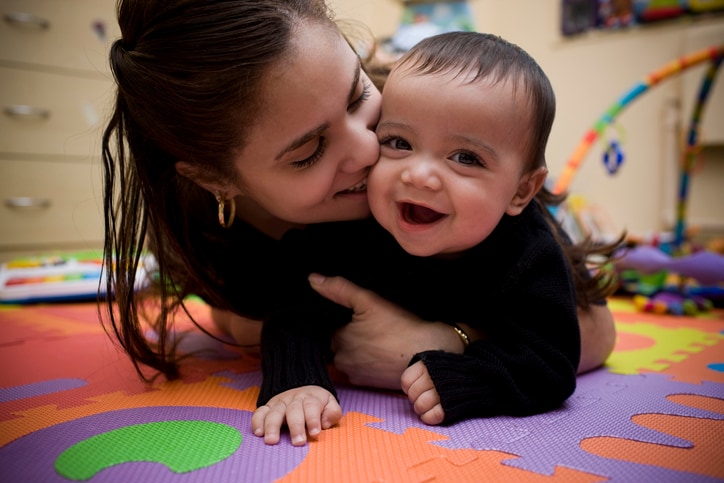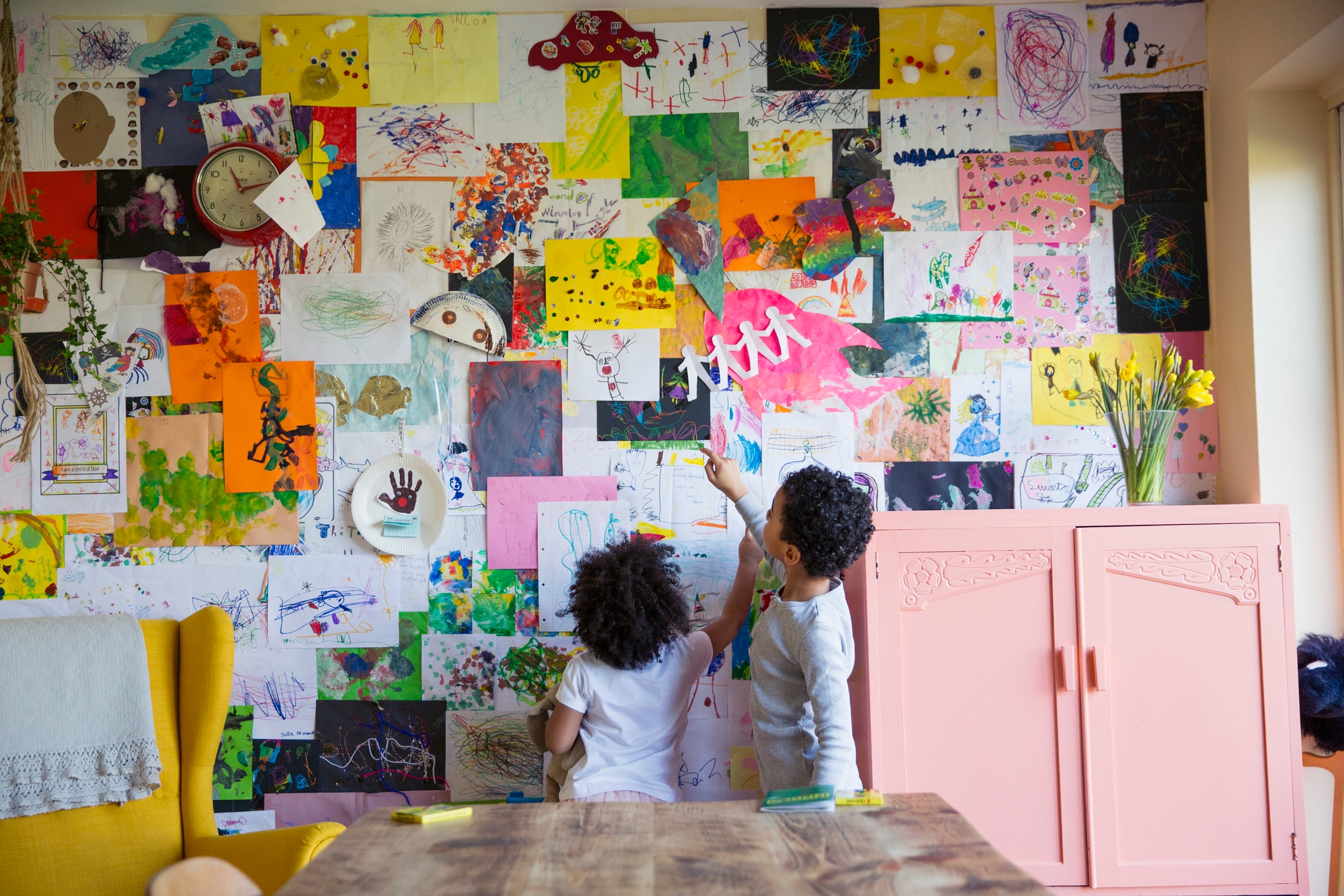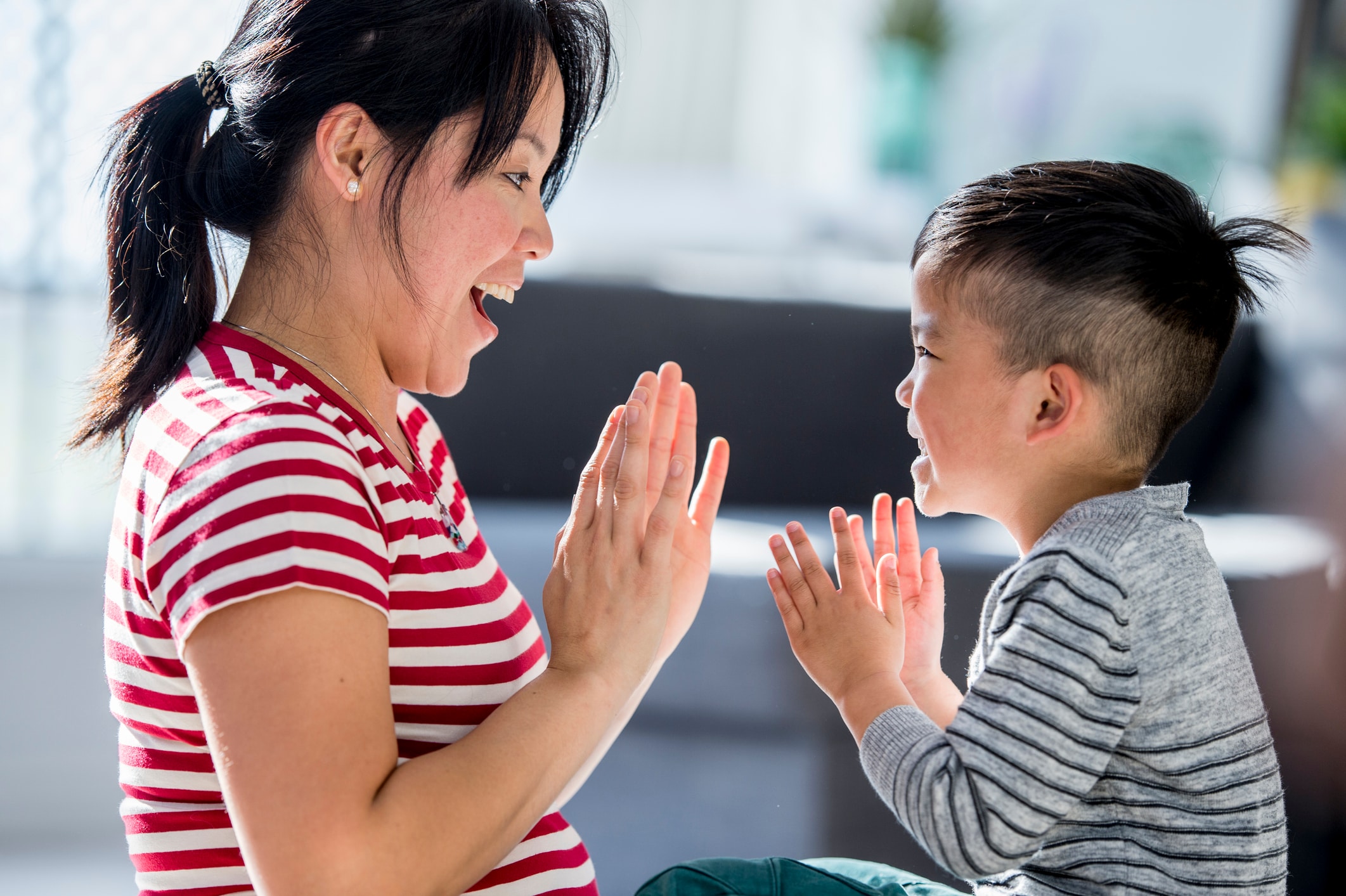Playtime is so important for infants and babies; after all, it is through play that children acquire muscle control, brain development and language and social skills. Talking to baby, engaging in eye contact, singing songs and playing simple games are all baby activities that can benefit their growth and development.
“Play provides an opportunity to build strength in muscles and understanding in the brain for how to interpret a child’s environment,” says Amy Baez, a pediatric occupational therapist, author and founder of Playapy, “Babies learn from play through simple activities like moving their eyes and holding their arms up to holding a bottle and lifting their heads up off the floor. Each activity is a stepping stone to gaining the foundation for future skills.”
That’s where parents and caregivers come in. It’s your job to provide them with stimulating, fun baby activities. “Parents are a baby’s first teacher, and babies learn through play, so it’s critical that parents engage with their children through play,” says Dr. Anne Zachry, pediatric occupational therapist, child development specialist and author of the baby activity book “Retro Baby.”
Tapped for fun baby activities and looking for inspiration? Here are 101 activities for babies that will not only keep little ones engaged but can also provide several kinds of developmental support, too.
Social activities for babies
- Look at a photo album, and name the people in the pictures.
- Play copycat. Copy their faces or gestures, or make a face and watch them imitate.
- Play peekaboo.
- Dance with baby. Hold them on your hip, put on some music and dance and spin with them in your arms.
- Play pat-a-cake.
- Roll a ball back and forth.
- Bounce them on your knees while making silly faces at them.
- Create a simple, personalized story for baby with a theme like “My Family” or “Baby’s Busy Day,” and use photographs of familiar family members and activities throughout to illustrate it. Laminate pages or keep them in plastic dividers so they can look at it frequently.
- Look at yourselves in a mirror.
- Play with hand puppets.
- Teach them simple hand gestures and baby signs like high fives, blowing kisses and waving bye-bye.
- Do finger-play songs like “Open, Shut Them” to learn about opposites.
- Play with stuffed animals. Teach them how to gently pet, feed and care for their plush toys.
- Read books, every day.
Physical activities for babies
- Pull them gently from a sitting position onto their feet.
- Help them roll from back to tummy by shaking a rattle just out of reach in the direction that they’re reaching.
- Give them a gentle massage with lotion.
- Spread different toys on their blanket during tummy time to encourage them to reach for them.
- Crawl through cloth tunnels, or make a tunnel from cardboard boxes.
- Pick up the puffs. For babies who have started eating solid cereals, place one cereal puff or “O” in each square of an ice cube tray and have them pick them out.
- Pretend to ride a bike. Bicycle baby’s legs round and round in a circular motion, gently and then faster and faster, to their liking.
- Play with alphabet magnets on the fridge. This activity is only appropriate once they are no longer mouthing toys because magnets are dangerous if ingested.
- Explore kitchen utensils. Play with them in a bucket of water, or stir food like uncooked pasta in a large bowl.
- Dig in gelatin. Suspend several toys in a bowl of gelatin and let baby fish them out with their fingers.
- Make shadow puppets in the light of a lamp.
- Make a ball pit. Fill an inflatable kiddie pool with colored plastic balls, and plop them down right in the middle of them.
- Get into yoga with baby by trying a class.
- Crawl over cushions. Make a soft “baby obstacle course” for crawlers with pillows, blankets and cushions.
- Give them horsey rides. Place them on your back and gently gallop around the room making horse noises.
Activities to get babies talking and making sounds
- Sing “Itsy Bitsy Spider,” complete with hand gestures.
- Play with large bells. String several bells on a ribbon and let them jingle them.
- Imitate animal noises and movements.
- Play “This Little Piggy” with their toes.
- Play drums with your hands by banging on overturned plastic bowls.
- Shake it up! Make baby maracas by filling empty water bottles with rice, beans or uncooked pasta.
- Sing “Head, Shoulders, Knees and Toes” while helping them touch the corresponding body part.
- Play with a tambourine.
- Make a rubber band guitar. Wrap large bands around a shoe box and let them strum them to make music.
- Play with rhythm sticks. Use two 3/4-inch round, 6-inch long pieces of doweling. Tap rhythms on buckets or tap the sticks together in a pattern.
- Beep beep! Drive toy cars making “horn” noises.
- Teach them body parts by gently touching each one while naming it.
Activities that get babies thinking and processing
- Build a tower of blocks.
- Play with stacking cups or measuring cups.
- Drop craft sticks or cotton swabs through the holes in an empty Parmesan cheese container to practice fine motor skills.
- Play with large interlocking blocks.
- Play with knob puzzles, placing your hand over theirs to help them.
- Drop clothes pins into a milk carton, dump and repeat.
- Expose young infants to contrasting black and white images to improve their visual perception.
- Put scarves or socks in a paper towel tube, and have them pull them out.
- Play with a funnel. Experiment with water, beans, rice, dried baby cereal or other textures.
- Count their fingers and toes.
- Hide the toy. Cover a toy with a blanket and have their find it.
- Play “which hand?” Hide an object in one hand, and have them find the hidden item.
- Match colors. Sort blocks, foam letters or even shirts into piles of different colors, saying the name of each color.
Art activities for babies
- Finger paint with pudding or yogurt. Let them paint a piece of paper or their high chair tray without worrying about their fingers going in their mouth.
- Play with sidewalk chalk.
- Scribble on paper. Using the oversized children’s crayons, help them draw. You will need to use the hand-over-hand technique to help them grasp the crayon.
- Finger paint in a bag. Squirt paints in a resealable plastic bag and tape the bag to the table. Let them “paint” by squishing the paint around in the bag.
- Play with stickers. On paper or on skin, the sticky texture will amaze them.
- Make baby-safe cloud dough.
- Make colorful water bottles. Fill empty plastic bottles with colored water, glitter, beads, sequins and other supplies, and let them shake them up.
- Paint with ice cubes. Freeze water with food coloring in it, and melt it on paper or the sidewalk.
Sensory activities for babies
- Make a sticky ball by wrapping tape tightly around a ball, sticky side out.
- Explore textures by making a sensory bin. Fill a box with scraps of fabric, old scarves, socks, bits of towel and so forth so they can feel the different fabrics and textures.
- Touch snow.
- Cut a foam pool noodle into 2-inch wide sections, and let them take a bath with the fun floating pieces.
- Make salt dough impressions of their hands and feet.
- Wrap some toys up like presents. They’ll enjoy the game of unwrapping them.
- Explore sticky paper. Secure a piece of contact paper to the floor, sticky side up. Let them walk on it, touch it, place toys on it, drive cars on it and so forth.
- Make a baby oil sensory bag.
- Fill a resealable bag full with shaving cream. They can explore the cool texture, without fear of ingesting it.
- Walk barefoot in the grass.
- Play with dyed spaghetti noodles. Watch infant carefully if they aren’t yet eating solids.
- Play in edible sand. If baby is old enough, make a batch of finely crushed graham crackers in a food processor and let them play in it as you would a sand table.
- Play with bubble wrap. Tape a large piece of bubble wrap to the ground and let them crawl over it, popping bubbles as they go.
- Play with ice cubes in the bathtub. Make several colored ice cubes and let them play with them while they melt in the warm bath, coloring the water, for a fun sensory experience.
Baby activities that get you both out of the house
- Go for a walk in the stroller.
- Sign up for an interactive Mommy and Me class (or “Daddy and Me” or “Babysitter and Me” class).
- Take a wagon ride.
- Explore water. Fill a shallow pot with water, and let them play in it with different toys and cups on the kitchen floor or in the backyard.
- Take a push toy for a walk.
- Play with bubbles in the park.
- Go on a nature walk. Feel the bark on the trees, touch the grass, smell a flower and pick a leaf.
- Wade in a kiddie pool.
- Feed the birds, ducks or squirrels — just make sure local laws don’t prohibit it.
- Splash in a mud puddle.
- For a child who is walking, take them for a quick walk in a warm, gentle rain shower.
- Help them go down an infant slide at the park.
Activities that may invoke pure baby joy (repeat if they do!)
- Sing “The Wheels on the Bus” and move them up and down, round and round, and back and forth with the lyrics.
- Give them raspberries on their tummy.
- Play rolling pin. Gently roll baby back and forth like they are rolling out cookies.
- Push them around in a laundry basket or a cardboard box once they have mastered sitting.
- Play “soooo big” and stretch their arms out wide.
- Push them in a swing.
- Take a rain bath together. Poke several holes in plastic containers, fill with water and hold them overhead, letting the water rain down on your heads.
- Tickle them with a feather, a cotton ball or soft, clean paintbrush.
- Play with flashlights in a darkened room.
- Gently bounce them on their bottom on an exercise ball or your lap.
- If they’re walking, chase them saying, “I’m gonna get you!” Then tickle them gently when you catch them.
- Roll baby on their tummy on an exercise ball.
- Play “super baby.” Support baby on their tummy and walk them around the room like they are flying.





